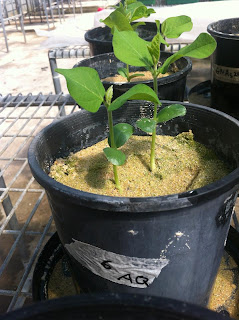Recently, when we have been telling people about our project, we have been getting the same responses back. Therefore, Georgia kindly compiled the following:
1. What is vermicomposting and vermicompost
leachate?
Vermicomposting, also known as
wormfarming, is a waste management technique using worms to transform organic
waste into biologically-rich manure (Carlos et al, 2008). Vermicompost leachate
(VCL), or ‘worm tea’, is the liquid released by earthworms (Kandari et al,
2011). VCL is said to stimulate plant nutrient uptake and support plant
development due to the humic acids, fluvic acids and plant growth regulators it contains. (Carlos et al, 2008).
2. What is the aim of your experiment?
Our experiment aims to determine if VCL is more effective fertiliser compared to an inorganic equivalent, which, in our case, is Aquasol.
3. Why are you using aquasol?
We chose to
use aquasol as it is a common purely synthetic fertiliser, which means it has
no biological component. Other common commercial fertilisers such as Seasol and Nitrosol were not chosen, as they are organically based (from seaweed extract and blood and bone respectively) have growth promoters added (Zodape, 2001).
4. Why are you growing lettuce and soybean
plants?
As nitrogen is the key element in
most fertilisers, we chose test the effectiveness of VCL and Aquasol on a nitrogen fixing
plant (soybean) as well as a non-nitrogen fixer (lettuce) that is common in urban gardens. These plants
were also chosen due to their rapid growth to suit our study’s limited timeframe.
5. Why are you growing the plants in sand?
Soil structure has a great affect on plant growth as it
influences the movement of water, air and nutrients to plants (Charman and
Murphey, 1992). As we did not want any differences in soil structure between pots, sand is being used, as it has very low inherit biological activity, and little to no structure.
6. What is the difference between normal
leachate and autoclaved leachate?
As vermicomposting is an organic process,
VCL contains both a biological component (micro-organisms) and a
chemical component. Autoclaving is a process of sterilising, or killing the
biological component that would be present. By comparing plants grown with normal leachate and
autoclaved leachate, this will show us if VCL’s fertilising ability is due to
its inherit biological activity, or if it is the chemical composition alone, that makes it a viable fertiliser.
7. Why are some of the plants being only
given water?
As with any scientific investigation, there are control plants being grown, that are only receiving water daily. These plants will show the growth of plants in absence of fertiliser.
If you have any more questions, please keep them coming!
Watering the lettuces last saturday
References
- Carlos, G, Dendooven, L, Antonio, G,
2008, Vermicomposting leachate (worm tea) as liquid fertiliser for maize (Zea
mays L.), Academic Journals Inc, USA.
- Kandari, L, Kulkarni, M, Staden, J, 2011,
Vermicompost leachate improves seedling emergence and vigour of aged seeds of
commercially grown Eucalyptus species, Southern Forest: Journal of Forest
Science, vol 77, 2, 534-535.
- Zodape, S, 2001, ‘Seaweeds as a biofertiliser’,
Journal of Scientific & Industrial Research Volume, vol. 60, 5,
378-382.
- Charman, P, Murphey, B, 1992, Soils their properties and management. Soil Conservation Commission of
NSW. Sydney University Press. Chapter 16. Soils and farming practice.
Harte, A.J.













